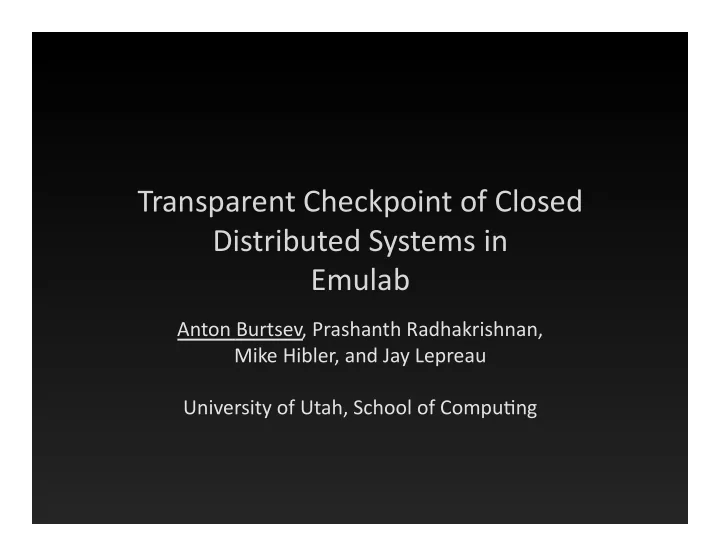

Transparent Checkpoint of Closed Distributed Systems in Emulab Anton Burtsev, Prashanth Radhakrishnan, Mike Hibler, and Jay Lepreau University of Utah, School of CompuEng
Emulab • Public testbed for network experimentaEon • Complex networking experiments within minutes 2
Emulab — precise research tool • Realism: – Real dedicated hardware • Machines and networks – Real operaEng systems – Freedom to configure any component of the soNware stack – Meaningful real‐world results • Control: – Closed system • Controlled external dependencies and side effects – Control interface – Repeatable, directed experimentaEon 3
Goal: more control over execuEon • Stateful swap‐out – Demand for physical resources exceeds capacity – PreempEve experiment scheduling • Long‐running • Large‐scale experiments – No loss of experiment state • Time‐travel – Replay experiments • DeterminisEcally or non‐determinisEcally – Debugging and analysis aid 4
Challenge • Both controls should preserve fidelity of experimentaEon • Both rely on transparency of distributed checkpoint 5
Transparent checkpoint • TradiEonally, semanEc transparency: – Checkpointed execuEon is one of the possible correct execuEons • What if we want to preserve performance correctness? – Checkpointed execuEon is one of the correct execuEons closest to a non‐checkpointed run • Preserve measurable parameters of the system – CPU allocaEon – Elapsed Eme – Disk throughput – Network delay and bandwidth 6
TradiEonal view • Local case – Transparency = smallest possible downEme – Several milliseconds [Remus] – Background work – Harms realism • Distributed case – Lamport checkpoint • Provides consistency – Packet delays, Emeouts, traffic bursts, replay buffer overflows 7
Main insight • Conceal checkpoint from the system under test – But sEll stay on the real hardware as much as possible • “Instantly” freeze the system – Time and execuEon – Ensure atomicity of checkpoint • Single non‐divisible acEon • Conceal checkpoint by Eme virtualizaEon 8
ContribuEons • Transparency of distributed checkpoint • Local atomicity – Temporal firewall • ExecuEon control mechanisms for Emulab – Stateful swap‐out – Time‐travel • Branching storage 9
Challenges and implementaEon 10
Checkpoint essenEals • State encapsulaEon – Suspend execuEon – Save running state of the system • VirtualizaEon layer 11
Checkpoint essenEals • State encapsulaEon – Suspend execuEon – Save running state of the system • VirtualizaEon layer – Suspends the system – Saves its state – Saves in‐flight state – Disconnects/reconnects to the hardware 12
First challenge: atomicity • Permanent encapsulaEon is harmful – Too slow – Some state is shared • Encapsulated upon checkpoint • Externally to VM – Full memory virtualizaEon – Needs declaraEve descripEon ? of shared state • Internally to VM – Breaks atomicity 13
Atomicity in the local case • Temporal firewall – SelecEvely suspends execuEon and Eme – Provides atomicity inside the firewall • ExecuEon control in the Linux kernel – Kernel threads – Interrupts, excepEons, IRQs • Conceals checkpoint – Time virtualizaEon 14
Second challenge: synchronizaEon • Lamport checkpoint $%#! – No synchronizaEon ??? Timeout – System is parEally suspended • Preserves consistency – Logs in‐flight packets • Once logged it’s impossible to remove • Unsuspended nodes – Time‐outs 15
Synchronized checkpoint • Synchronize clocks across the system • Schedule checkpoint • Checkpoint all nodes at once • Almost no in‐flight packets 16
Bandwidth‐delay product • Large number of in‐ flight packets • Slow links dominate the log • Faster links wait for the enEre log to complete • Per‐path replay? – Unavailable at Layer 2 – Accurate replay engine on every node 17
Checkpoint the network core • Leverage Emulab delay nodes – Emulab links are no‐delay – Link emulaEon done by delay nodes • Avoid replay of in‐flight packets • Capture all in‐flight packets in core – Checkpoint delay nodes 18
Efficient branching storage • To be pracEcal stateful swap‐out has to be fast • Mostly read‐only FS – Shared across nodes and experiments • Deltas accumulate across swap‐outs • Based on LVM – Many opEmizaEons 19
EvaluaEon
EvaluaEon plan • Transparency of the checkpoint • Measurable metrics – Time virtualizaEon – CPU allocaEon – Network parameters 21
Time virtualizaEon Timer accuracy is 28 μsec do { usleep(10 ms) Checkpoint every 5 sec Checkpoint adds ±80 μsec germeofday() (24 checkpoints) error } while () sleep + overhead = 20 ms 22
CPU allocaEon Checkpoint adds 27 ms error do { Normally within 9 ms stress_cpu() of average Checkpoint every 5 sec germeofday() (29 checkpoints) } while() stress + overhead = 236.6 ms ls /root – 7ms overhead xm list – 130 ms 23
Network transparency: iperf Throughput drop is due to background acEvity ‐ 1Gbps, 0 delay network, Checkpoint every 5 sec ‐ iperf between two VMs Average inter‐packet Eme: 18 μsec (4 checkpoints) ‐ tcpdump inside one of VMs Checkpoint adds: 330 ‐‐ 5801 μsec ‐ averaging over 0.5 ms No TCP window change No packet drops 24
Network transparency: BitTorrent Checkpoint every 5 sec 100Mbps, low delay (20 checkpoints) 1BT server + 3 clients 3GB file Checkpoint preserves average throughput 25
Conclusions • Transparent distributed checkpoint – Precise research tool – Fidelity of distributed system analysis • Temporal firewall – General mechanism to change percepEon of Eme for the system – Conceal various external events • Future work is Eme‐travel 26
Thank you aburtsev@flux.utah.edu
Backup 28
Branching storage • Copy‐on‐write as a redo log • Linear addressing • Free block eliminaEon • Read before write eliminaEon 29
Branching storage 30
Recommend
More recommend